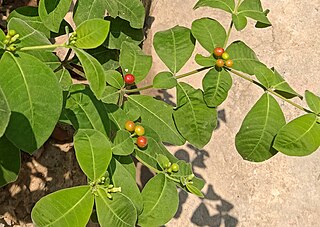
Apocynaceae is a family of flowering plants that includes trees, shrubs, herbs, stem succulents, and vines, commonly known as the dogbane family, because some taxa were used as dog poison. Members of the family are native to the European, Asian, African, Australian, and American tropics or subtropics, with some temperate members. The former family Asclepiadaceae is considered a subfamily of Apocynaceae and contains 348 genera. A list of Apocynaceae genera may be found here.

Catharanthus is a genus of flowering plants in the family Apocynaceae. Like the genus Vinca, they are known commonly as periwinkles. There are eight known species. Seven are endemic to Madagascar, though one, C. roseus, is widely naturalized around the world. The eighth species, C. pusillus, is native to India and Sri Lanka. The name Catharanthus comes from the Greek for "pure flower".

Medicinal plants, also called medicinal herbs, have been discovered and used in traditional medicine practices since prehistoric times. Plants synthesize hundreds of chemical compounds for various functions, including defense and protection against insects, fungi, diseases, and herbivorous mammals.

Phytochemistry is the study of phytochemicals, which are chemicals derived from plants. Phytochemists strive to describe the structures of the large number of secondary metabolites found in plants, the functions of these compounds in human and plant biology, and the biosynthesis of these compounds. Plants synthesize phytochemicals for many reasons, including to protect themselves against insect attacks and plant diseases. The compounds found in plants are of many kinds, but most can be grouped into four major biosynthetic classes: alkaloids, phenylpropanoids, polyketides, and terpenoids.

Reserpine is a drug that is used for the treatment of high blood pressure, usually in combination with a thiazide diuretic or vasodilator. Large clinical trials have shown that combined treatment with reserpine plus a thiazide diuretic reduces mortality of people with hypertension. Although the use of reserpine as a solo drug has declined since it was first approved by the FDA in 1955, the combined use of reserpine and a thiazide diuretic or vasodilator is still recommended in patients who do not achieve adequate lowering of blood pressure with first-line drug treatment alone. The reserpine-hydrochlorothiazide combo pill was the 17th most commonly prescribed of the 43 combination antihypertensive pills available In 2012.

Sida rhombifolia, commonly known as arrowleaf sida, is a perennial or sometimes annual plant in the Family Malvaceae, native to the Old World tropics and subtropics. Other common names include rhombus-leaved sida, Paddy's lucerne, jelly leaf, and also somewhat confusingly as Cuban jute, Queensland-hemp, and Indian hemp. Synonyms include Malva rhombifolia. It is used in Ayurvedic medicine, where it is known as kurumthotti.

Rauvolfia is a genus of evergreen trees and shrubs, commonly known as devil peppers, in the family Apocynaceae. The genus is named to honor Leonhard Rauwolf. The genus can mainly be found in tropical regions of Africa, Asia, Latin America, and various oceanic islands.

Physocarpus, commonly called ninebark, is a genus of flowering plants in the family Rosaceae, native to North America and northeastern Asia.

Indole alkaloids are a class of alkaloids containing a structural moiety of indole; many indole alkaloids also include isoprene groups and are thus called terpene indole or secologanin tryptamine alkaloids. Containing more than 4100 known different compounds, it is one of the largest classes of alkaloids. Many of them possess significant physiological activity and some of them are used in medicine. The amino acid tryptophan is the biochemical precursor of indole alkaloids.

Salimuzzaman Siddiqui, was a Pakistani organic chemist specialising in natural products, and a professor of chemistry at the University of Karachi.

Ajmaline is an alkaloid that is classified as a 1-A antiarrhythmic agent. It is often used to induce arrhythmic contraction in patients suspected of having Brugada syndrome. Individuals suffering from Brugada syndrome will be more susceptible to the arrhythmogenic effects of the drug, and this can be observed on an electrocardiogram as an ST elevation.

Anaphalis margaritacea, commonly known as the western pearly everlasting or pearly everlasting, is an Asian and North American species of flowering perennial plant in the family Asteraceae.
Strictosidine synthase (EC 4.3.3.2) is an enzyme in alkaloid biosynthesis that catalyses the condensation of tryptamine with secologanin to form strictosidine in a formal Pictet–Spengler reaction:

Ribes aureum, known by the common names golden currant, clove currant, pruterberry and buffalo currant, is a species of flowering plant in the genus Ribes native to North America.

Corynanthine, also known as rauhimbine, is an alkaloid found in the Rauvolfia and Corynanthe genera of plants. It is one of the two diastereoisomers of yohimbine, the other being rauwolscine. It is also related to ajmalicine.

Rauvolfia vomitoria, the poison devil's-pepper, is a plant species in the genus Rauvolfia. It is native from Senegal east to Sudan and Tanzania, south to Angola; and naturalized in China, Bangladesh, different ranges of Himalayan and Puerto Rico. The plant contains a number of compounds of interest to the pharmaceutical industry and is widely used in traditional medicine.

Rauvolfia tetraphylla is a plant in the family Apocynaceae, growing as a bush or small tree. It is commonly known as the be still tree or devil-pepper. The plant is native to Mexico, Central America, West Indies, and northern South America. It has been cultivated widely as both an ornamental and for use in traditional medicine. It is now naturalized throughout the tropics including Australasia, Indochina, and India.
Rauvolfia sumatrana is a tree in the family Apocynaceae.
Rauvolfia micrantha, the small-flowered snakeroot, is a plant that is indigenous to southwestern India, southern Thailand, and Vietnam. It has a woody, shrub-like appearance and attractive flowers.

Serpentine is a terpene indole alkaloid produced by several members of the family Apocynaceae, including Catharanthus roseus and Rauvolfia serpentina.




















